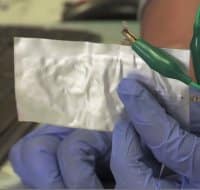The decades-long search for a safe, fast-charging, long-lasting and inexpensive aluminium-ion battery may soon be over thanks to Stanford University scientists.
An effective battery based on aluminium has been a holy grail of sorts for battery researchers as aluminum is plentiful, has low flammability and high energy storage attributes.
One of the major challenges has been finding the complementary materials suited to repeated charge and discharge cycles.
“We accidentally discovered that a simple solution is to use graphite, which is basically carbon,” said Hongjie Dai, a professor of chemistry at Stanford. ” In our study, we identified a few types of graphite material that give us very good performance.”
The experimental battery features an aluminum anode and a 3D graphite foam cathode plus an ionic liquid electrolyte inside a flexible polymer- coated pouch.
Demonstrating the safety of the battery, the scientists showed drilling through the battery pouch to be safe. Drilling through a lithium-ion battery can result in a fire or explosion. Other conditions can also trigger a thermal runaway scenario in lithium batteries – something that has made some airlines very nervous about shipping large quantities.
The Stanford battery also demonstrates a high cycle life – more than 7,500 cycles without any loss of capacity – and can be recharged in one minute. A typical lithium-ion battery lasts about 1,000 cycles.
The aluminum battery generates about two volts of electricity. While that is higher than anyone has achieved previously with aluminium, Professor Dai acknowledges more work needs to be done to match lithium-ion voltage, which will involve improving the cathode material.
” Otherwise, our battery has everything else you’d dream that a battery should have: inexpensive electrodes, good safety, high-speed charging, flexibility and long cycle life. I see this as a new battery in its early days. It’s quite exciting.”
If the aluminium-ion battery’s capabilities can be refined even further, it could have some major positive implications for electric vehicles and wind and solar power storage applications.
Professor Dai and his fellow researchers have recorded their findings in “An ultrafast rechargeable aluminum-ion battery,” published in the April 6 online edition of the journal Nature












































